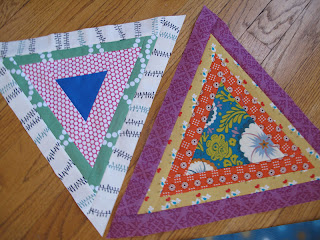Batting & Basting
>> Wednesday, February 29, 2012
I keep scraps: fabric scraps, flannel scraps, batting scraps. I've become a little more ruthless over the years, only keeping scraps of a reasonable (to me) size and flannel/batting pieces that I could realistically use. I was ready to baste a quilt with what I thought was a sufficiently large piece o' batting, only to find out that it was a touch too slim. At which point I not only remembered my bag of batting pieces but also that it's possible to fuse batting pieces together. Well, fuse via sewing machine, not heat. That zig-zag stitch will nicely unite batting in a seam that needs no pressing and therefore has no extra bulk. It was super easy to do. And provided me with just the right size of batting.
At which point I moved onto basting. I am going to let you in on a big secret: I break all the rules of basting. I do not tape anything to the floor. In fact, if I'm basting a big quilt, I don't have enough floor space to lay everything out and keep it all smooth. So I've developed a trademark lazy two.hippos method (patent pending, of course). First I iron the batting and the backing. This gets everything all smooth and keeps the two pieces together (fabric "sticks" to batting as it is, this just gets it into place nicely). Then I lay it on the floor, sometimes draped partially over the area rug (bottom left) that has nowhere else to go. Then I place the top on the batting, arrange it just so, and pick a spot to start pinning. In the case above, I started from the side you can no longer see, opposite the end you can (does that make any sense?)
Depending on the design of the front and the back as well as how much extra room I have to work with (because, shhh, I don't always make the batting 2" wider and longer and the backing 4" wider and longer. Sometimes I do, and sometimes I don't), I start pinning from the middle or from a corner. (If you need the corner to stay just so, it's best to start there and work outward in a fan pattern). Then I start pinning. I purposefully don't tape anything so I can move things around and smooth out potential puckers as I work. I find this adaptive method much better than having things taped down and accidentally pinning puckers. It's not that no puckers ever form this way but rather that if and when they do, I'm more likely to feel them and fix them as I go. I will often reach under the quilt to feel and shift the backing. Much easier to do this when there's no tape in the way. And, when space (or lack thereof) demands it, I start rolling the quilt up to get the remainder of the quilt sitting evenly on the floor to finish. also, this creates a nice buffer for your knees, which usually want some cushion by this point in basting. I should note that rolling works only if you start pinning from one side rather than the middle.
And with that, happy leap day! I'm flying back to Michigan today. Woot. Read more...
At which point I moved onto basting. I am going to let you in on a big secret: I break all the rules of basting. I do not tape anything to the floor. In fact, if I'm basting a big quilt, I don't have enough floor space to lay everything out and keep it all smooth. So I've developed a trademark lazy two.hippos method (patent pending, of course). First I iron the batting and the backing. This gets everything all smooth and keeps the two pieces together (fabric "sticks" to batting as it is, this just gets it into place nicely). Then I lay it on the floor, sometimes draped partially over the area rug (bottom left) that has nowhere else to go. Then I place the top on the batting, arrange it just so, and pick a spot to start pinning. In the case above, I started from the side you can no longer see, opposite the end you can (does that make any sense?)
Depending on the design of the front and the back as well as how much extra room I have to work with (because, shhh, I don't always make the batting 2" wider and longer and the backing 4" wider and longer. Sometimes I do, and sometimes I don't), I start pinning from the middle or from a corner. (If you need the corner to stay just so, it's best to start there and work outward in a fan pattern). Then I start pinning. I purposefully don't tape anything so I can move things around and smooth out potential puckers as I work. I find this adaptive method much better than having things taped down and accidentally pinning puckers. It's not that no puckers ever form this way but rather that if and when they do, I'm more likely to feel them and fix them as I go. I will often reach under the quilt to feel and shift the backing. Much easier to do this when there's no tape in the way. And, when space (or lack thereof) demands it, I start rolling the quilt up to get the remainder of the quilt sitting evenly on the floor to finish. also, this creates a nice buffer for your knees, which usually want some cushion by this point in basting. I should note that rolling works only if you start pinning from one side rather than the middle.
And with that, happy leap day! I'm flying back to Michigan today. Woot. Read more...

























